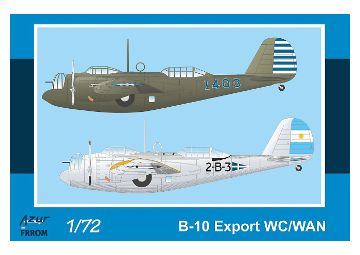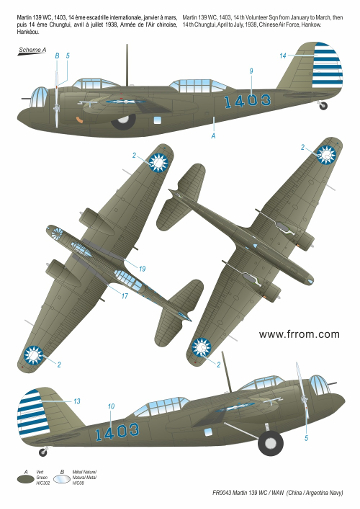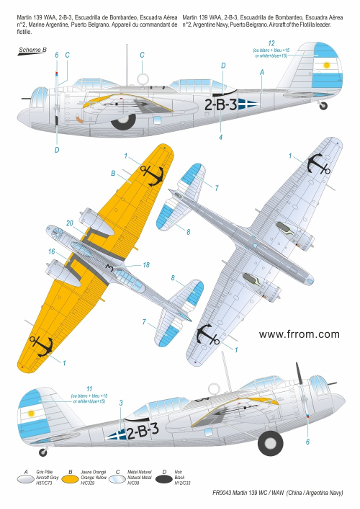FR0043 B-10B Export WC/WAN
History:
The prototype B-10 first flew on February 16, 1932, with delivery to the US Army Air Corps (USAAC) for testing on March 20. The B-10 combined several innovations including an all-metal airframe, fully cowled engines, retractable landing gear, enclosed gun-turret, and internal bomb-bay, which helped make it faster than fighters then in service and all other bombers obsolete. In doing so, it set the pattern that most subsequent bomber designs would emulate until the jet-age. Although built in relatively small numbers, the B-10 was revolutionary, and was the USAAC’s first all-metal monoplane bomber.

It defined the transition in eras from fabric-covered biplane to all-metal streamlined monoplane bombers defended by enclosed gun positions. In 1933, 14 pre-production YB-10s were ordered in January and delivered in November. The USAAC received 103 of the main production version, the B-10B, equipped with more powerful 675 hp Wright Cyclone R-1820-19 engines, and seven equipped with Pratt & Whitney Hornet engines which were designated B-12.
The B-10 was cleared for export in July 1936 as the Model 139 with Wright engines and received designations reflecting the model (139), engine (W for Wright), country (first letter), and service user if applicable (A for army and N for navy). Customers included China (nine 139 WC), Argentina (22 139 WAA and 12 139 WAN), Turkey (20 139 WT), the Kingdom of Siam (six 139 WSM), and the Dutch East Indies which was the biggest user (13 139 WH-1, 26 139 WH-2, as well as 82 of an improved version, the Model 166 WH-3). One plane was also exported to the Soviet Union (139 WR) and another one to Japan (139 WJ). The latter country captured a few 139 WH-2 and WH-3 after the invasion of the Dutch East Indies, and passed these on to the Thai Air Force in 1944. The Kingdom of Siam used its 139 WSM against French Indo-China during the Franco-Thai war of January/February 1941
The Chinese aircraft were assigned to the 30th Chungtui (squadron) of the 8th Tatui (Group) to the Chinese Air Force’s heavy bomber force based in Hsingsiang (Honan), and coded from 3000 to 3009. They were painted in the standard American finish of yellow wings and blue fuselage upon delivery in 1937 (six in February and three in August). Aircraft number 3002 was destroyed during training.
At the beginning of the war with Japan in July 1937, the Models 139 WC were camouflaged in olive green. Aircraft 3001 and 3006 attacked the Japanese troops shipped to Shanghai on the night of August 16th, and 3006 being destroyed on landing. On 24 August, the Chinese Air Force attacked a new Japanese landing near Shanghai, throwing all its available bombers in the battle: Model 139s 3001 and 3005, Heinkels 1902, 1903 (or 1904), and 1905, and Shrikes of the 9th Tatui, with five Model 281s for the fighter escort. A lack of coordination led to the raid’s failure, which included the loss of two Heinkels, and the replacement of the Model 139’s unit commander. Further training led to the loss of two 139 WCs, then a third (3001) again on landing. 3005 was destroyed on 22 October after a successful attack on Paoshan airfield (Shanghai), with another aircraft being lost in December.
Two surviving Model 139s were finally transferred in early 1938 to the 14th (International) Chungtui and renumbered 1403 and 1404. When this unit was disbanded in April, they were assigned to the 14th Chungtui where they kept their assigned codes. These aircraft raided Southern Japan from airfields near Shanghai during the night of 19-20 May, 1938, but were lightly loaded with only propaganda leaflets because of the long distance to be flown. On 4 July, 1938, these two aircraft bombed enemy positions in Shanghai, and were written off the inventory shortly afterwards.
In 1937, the Argentine Navy bought 12 Model 139 WANs, equipped with two Wright R-1820-G2 engines, and also obtained the company demonstrator aircraft, which was fitted with less powerful R-1820-G3s (that powered the Army's 139 WAAs). The aircraft were delivered at the end of 1937, and were assigned to the Bombing Squadrons of Escuadra Aérea n°2 (Puerto Belgrano) and n°3 (Rio de la Plata). They were used in maritime patrol operations, thanks to their long range, and carried anti-submarine depth-charges externally. A 139 WAN also served as a transport aircraft between the cities of Ushuaïa and Rio Grande, in Tierra del Fuego, from October 1944 to November 1946. At the beginning of 1946, the Model 139s WAN were assigned to the Plata Zone. They stopped flying in 1948 and were officially withdrawn from service in 1949.
They proved to be remarkably resilient in the Naval service, only aircraft number 3-B-6 (MSN 726) being destroyed in service on March 21, 1939. Although it was possible to mount floats on its Model 139s, the Argentine Navy never did so.
The camouflage schemes of the Argentine Navy Model 139s were quite eye-catching with yellow wings and light grey fuselage with anchor insignias on both wing surfaces.
Specifications (139 WAN): twin-engined monoplane bomber with retractable landing gear, metal construction, 4 crew members. Engines: two Wright Cyclone R-1820-G2 of 850 hp. Wingspan 21.49 m, length 13.63 m, wing area 63 m2. Maximum speed 306 kmh at sea level. Maximum altitude, 5,182 m. Offensive armament: 1,029 kg of bombs, defensive armament 3 Colt MG-40 cal .30" machine guns.
- Batailles Aériennes n°42 et 42 (on ML-KNIL, in french)
- Avions n°3, 4, 5 with informations on Model 139 WC in China, in french.
- Photos in the web.
- Martin 139W en Argentina, Jorge F. Nunez Padin, Fernando C. Benedetto (Spanish)
- Martin 139 WAN, Jorge F. Nunez Padin, (Museo de la Aviacion Naval - Instituto Aeronaval), Spanish
- Informations and photos generously transmitted by Mark Tutton, Starfighter Decals, on B-10B in Philippines (and elsewhere), by Michel Ledet on Model 139 WH-x in service with ML-KNIL, by Patrick Laureau on Model 139 WC in China, we want to thank them very much for their help !
Camouflages :
- Cam A : Model 139 WC, 1403, 14 th Volunteer Sqn from January to March, then 14 th Chungtui, April to July, 1938, Chinese Air Force, Hankow.
- Cam B : Model 139 WAA, 2-B-3, Escuadrilla de Bombardeo, Escuadra Aérea n°2, Argentine Navy, Puerto Belgrano. Aircraft of the Flotilla leader

